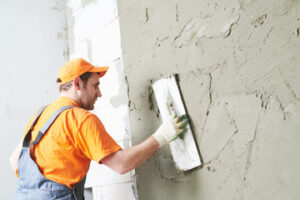Stucco Repair – Fixing Cracks, Holes and Cracks in Stucco
Stucco Repair may seem like an intimidating project, but it’s a task that most homeowners can accomplish with the right help. Cracks, holes, and stains are all signs that the stucco needs fixing. Small hairline cracks in stucco can be filled with exterior latex paintable caulk. Just be sure the caulk matches your stucco color. Read on Stucco Repair Philadelphia to learn more.
 Stucco is a plaster surface that can crack as it expands and contracts with seasonal weather changes. When you notice a hairline crack, it’s not necessarily structural damage and can usually be fixed with a bit of caulk. However, larger cracks indicate that there is a problem with the structure of your building and should be addressed right away.
Stucco is a plaster surface that can crack as it expands and contracts with seasonal weather changes. When you notice a hairline crack, it’s not necessarily structural damage and can usually be fixed with a bit of caulk. However, larger cracks indicate that there is a problem with the structure of your building and should be addressed right away.
Ideally, you should address these issues before they worsen and lead to serious problems like mold and dampness in your home or office. When you see these types of cracks, it’s best to hire a professional right away who can assess the damage and recommend the proper repair solution.
Cracks in stucco can occur for a variety of reasons, including the age of your building and weather conditions. They can also be a sign that your exterior walls are not being supported properly, which could result in more significant damage down the line.
If you notice a hairline crack in your stucco, you should try to repair it as soon as possible before it gets any wider. First, you’ll want to clear away any loose material. Then, using a cold chisel and hammer, widen the crack at least a quarter inch throughout its length. You may also need to back-chisel the edges of the crack gently a bit, so that they are beveled evenly.
Once you’ve widened the crack, fill it with a high-quality caulk that is designed to bond with stucco. It’s a good idea to use a product that has been specifically formulated for this type of project, such as Quikrete’s sanded caulk, which can match most stucco textures (view on Amazon).
The next step is to press into the wet caulk some coarse sand or fine gravel. This will help the sealant to adhere to the underlying stucco, and it will also add some strength to the crack. Finally, you can paint the area to cover up any smears and imperfections from the caulk job.
When repairing small cracks, you must be careful not to over-fill them, as this will only make them worse. If you have trouble determining how much caulk to use, consider using a small amount at first and then working it out with a trowel until you get the desired texture.
Holes
While stucco is known for its durability and longevity, like any material, it can be damaged over time. Cracks can deteriorate and eventually lead to holes in the stucco wall if left unattended. When this happens, water can seep into the interior walls causing serious damage and potentially leading to mold and mildew. This is why it is important to address cracks and holes as soon as you see them.
If you have small cracks or holes in your stucco, you can usually fix them with a high quality caulking. The type of caulking used will depend on the size of the hole or crack, but a polyurethane caulking is typically a good choice because it provides high quality protection and durability.
For larger holes, you will need to use a patching concoction. This can either be a pre-mixed bridging and patching compound that is ready to trowel on, or you will need to mix your own using a dry mix, following the manufacturer’s instructions. When applying the patching compound, you will need to use a rubber float or masonry trowel to apply a 0.25-inch thick layer. Multiple layers may be required to build up a solid patch for the hole. Once the patch is in place, you will need to smooth it out with a float or trowel and make sure that it sits flush with the surrounding surface of your stucco wall. Once the patch is smooth, it can be painted to match the color of your existing stucco.
In addition to hole repairs, you will also want to use a good quality exterior caulking to seal the area around the hole. This will ensure that water cannot seep underneath the surface of the stucco and cause additional problems.
In some cases, holes in the stucco can be caused by wildlife looking for food or shelter. Squirrels, mice and termites have been known to chew through stucco to create nests or to find a place to lay their eggs. Woodpeckers can likewise chip away at the surface of your stucco siding, leaving holes that will eventually enlarge if not repaired.
Chips
Stucco is a layered exterior. It has several layers including the base, a layer that holds the vapor barrier and then another protective coat over the vapor barrier. Damage to any of these layers can lead to water intrusion, hairline cracks and then more serious structural problems.
If you notice cracking in your stucco, have a professional come out to perform a thorough Stucco Leak Detection at your home. This is the only way to find out what is causing the damage, and how severe it is.
Once a contractor knows what is causing the damage, they can recommend the best repair plan. Generally, small repairs should be done as soon as you see them to prevent the cracks from widening and potentially exposing the framing of your house. For larger areas, a full repair might be necessary. A complete repair will usually include replacing the vapor barrier and metal lath, which can cost anywhere from $800 to $1500. The amount of labor and materials will also vary based on the size and location of the damage.
When repairing stucco, it is important to work in temperatures above freezing. Freezing temperatures will ruin the stucco mix by sucking out the moisture it needs to cure. Hot, dry weather can also interfere with the mix. It can cause the stucco to dry too quickly, causing it to shrink and not adhere to the metal mesh in the wall. It is also a good idea to wear gloves when working with fresh stucco, because it has alkalis that can burn your skin.
After the vapor barrier and metal lath have been repaired, you can begin working on the new layer of stucco. Use a trowel to apply a thick coat that is about three inches long over the damaged area of your house. Be sure to fill the entire crack with this new layer of stucco, and be sure it is level with the rest of the wall.
After the stucco has dried, you can paint it to match your existing color. You can also purchase coloring pigment to add to your stucco mix and try it on a piece of cardboard to see if you can get the color right before starting on your actual repairs.
Remediation
Stucco is a durable choice for exteriors, but it can get damaged. Repairing the damage is a smart way to protect the stucco and save money in the long run. However, some cracks, holes and other problems aren’t as easily fixed with a simple repair. These issues are symptomatic of deeper problems, and should be addressed with remediation instead of simply repaired to the surface.
When a home’s stucco is compromised, it can cause moisture to seep through the walls and ceilings in the form of unsightly spots and marks. It can also lead to mold infestations and rotted framing that is unhealthy for the structure of the home. This is why it is important to address any signs of trouble with stucco, whether they are small cracks or musk-smelling mold.
The first step in remediation is a thorough examination by a professional. This inspection can reveal the source of the problem and allow the builders to take care of any underlying issues. Once the outer layers of the stucco are removed, the builders can begin to replace any sheathing or framing that has been affected by water damage.
After the new sheathing and framing are in place, the builders can apply a fresh coat of stucco. This may require a number of coats, and it is important to let each one dry before applying the next. The painters can then paint the surface to match the color of the rest of the stucco.
This method of remediation is less costly than a full replacement, but it can still be expensive for homeowners and business owners. This is because the repairs are typically done on a smaller scale than a full renovation and because the repair process can be difficult for those who are not familiar with the material.
This type of remediation is recommended when the damage to the stucco is severe and can’t be fixed with a simple repair. This is because the cracks and holes in the stucco are caused by a deeper issue, which must be addressed with remediation to prevent the problem from recurring.
